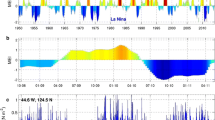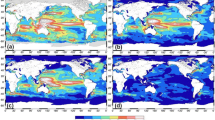Abstract
This study examines the circulation and associated monthly-to-seasonal variability in the Caribbean Sea using a regional ocean circulation model. The model domain covers the region between 99.0 and 54.0°W and between 8.0 and 30.3°N, with a horizontal resolution of 1/6°. The ocean circulation model is driven by 6-hourly atmospheric reanalysis data from the National Center for Environmental Prediction and boundary forcing extracted from 5-day global ocean reanalysis data produced by Smith et al. (Mercator Newsletter 36:39–49, 2010), and integrated for 7 years. A comparison of model results with observations demonstrates that the regional ocean circulation model has skill in simulating circulation and associated variability in the study region. Analysis of the model results, as well as a companion model run that uses steady annual mean forcing, illustrates the role of Caribbean eddies for driving monthly-to-seasonal circulation variability in the model. It is found that vertically integrated transport between Nicaragua and Jamaica is influenced by the interaction between the density perturbations associated with Caribbean eddies and the Nicaraguan Ridge. The impact of Caribbean eddies squeezing through the Yucatan Channel is also discussed.
















Similar content being viewed by others
References
Andrade CA, Barton ED (2000) Eddy development and motion in the Caribbean Sea. J Geophys Res 105:26191–26201
Andrade CA, Barton ED (2005) The Guajira upwelling. Cont Shelf Res 25:1003–1022
Baringer MO, Larsen JC (2001) Sixteen years of Florida Current transport at 27°N. Geophys Res Lett 28:3179–3182
Candela J, Tanahara S, Crepon M, Barnier B, Sheinbaum J (2003) Yucatan Channel flow: observations versus CLIPPER ATL6 and MERCATOR PAM models. J Geophys Res 108
Carton JA, Chao Y (1999) Caribbean Sea eddies inferred from TOPEX/POSEIDON altimetry and a 1/6° Atlantic Ocean model simulation. J Geophys Res 104:7743–7752
Cherubin LM, Sturges W, Chassignet EP (2005) Deep flow variability in the vicinity of the Yucatan Straits from a high-resolution numerical simulation. J Geophys Res 110:C04009
Ezer T, Oey L-Y, Lee H-C, Sturges W (2003) The variability of currents in the Yucatan Channel: analysis of results from a numerical ocean model. J Geophys Res 108:3012
Ezer T, Thattai DV, Kjerfve B, Heyman W (2005) On the variability of the flow along the Meso-American Barrier Reef System: a numerical model study of the influence of the Caribbean Current and eddies. Ocean Dyn 55:458–475
Gill AE (1982) Atmosphere-ocean dynamics. Academic, San Diego, p 662
Hernandez-Guerra A, Joyce TM (2000) Water masses and circulation in the surface layers of the Caribbean at 66°W. Geophys Res Lett 27:3497–3500
Horel JD (1984) Complex principal component analysis: theory and examples. J Climate Appl Meteor 23:1660–1673
Johns WE, Smith RH, Johns EM, Wilson WD (2008) The Caribbean mass budget revisited. Eos Trans. AGU, 89: Jt Assem Suppl, Abstract OS34A-03
Johns WE, Townsend TL, Fratantoni DM, Wilson WD (2002) On the Atlantic inflow to the Caribbean Sea. Deep Sea Res 49:211–243
Johns WE, Lee TN, Schott FA, Zantopp RJ, Evans RH (1990) The North Brazil current retroflection: seasonal structure and eddy variability. J Geophys Res 95:22103–22120
Jouanno J, Sheinbaum J, Barnier B, Molines JM (2008a) The mesoscale variability in the Caribbean Sea. Part II: energy sources. Ocean Modelling 26:226–239
Jouanno J, Sheinbaum J, Barnier B, Molines JM, Debreu L, Lemarie F (2008b) The mesoscale variability in the Caribbean Sea. Part I: simulations and characteristics with an embedded model. Ocean Modelling 23:82–101
Kalnay E et al (1996) The NCEP/NCAR 40-year reanalysis project. Bull Amer Meteor Soc 77:437–471
Lin Y, Greatbatch RJ, Sheng J (2009) A model study of the vertically integrated transport variability through the Yucatan Channel: role of Loop Current evolution and flow compensation around Cuba. J Geophys Res 114:C08003
Lin Y, Greatbatch RJ, Sheng J (2010a) The influence of Gulf of Mexico Loop Current intrusion on the transport of the Florida Current. Ocean Dyn 60:1075–1084
Lin Y, Sheng J, Greatbatch RJ (2010b) A numerical study of circulation and associated variability in the Intra-Americas Sea, Proc 11th Int Estuarine Coastal Mod, Seattle, WA, November 5–7, 2009. Editor: M. L. Spaulding, published by American Society of Civil Engineers, Reston, VA
Merrifield MA, Guza RT (1990) Detecting propagating signals with complex empirical orthogonal functions: a cautionary note. J Phys Oceanogr 20:1628–1633
Molinari RL, Spillane M, Brooks I, Atwood D, Duckett C (1981) Surface currents in the Caribbean Sea as deduced from Lagrangian observations. J Geophys Res 86:6537–6542
Mooers CNK, Maul GA (1998) Intra-Americas Sea circulation. In: Brink KH, Robinson AR (eds) The sea. Wiley, New York, p 1062
Murphy S, Hurlburt H, O'Brien J (1999) The connectivity of eddy variability in the Caribbean Sea, the Gulf of Mexico, and the Atlantic Ocean. J Geophys Res 104:1431–1453
Nof D (2005) The momentum imbalance paradox revisited. J Phys Oceanogr 35:1928–1939
Nof D, Pichevin T (2001) The ballooning of outflows. J Phys Oceanogr 31:3045–3058
Oey L-Y, Ezer T, Lee H-C (2005) Loop Current, rings and related circulation in the Gulf of Mexico: a review of numerical models and future challenges. In: Circulation in the Gulf of Mexico: observations and models. Sturges A and Lugo-Fernandez A (eds) Geophys Monograph Ser 161: 31–56, AGU, Washington, DC
Oey L-Y, Lee H, Schmitz WJ Jr (2003) Effects of winds and Caribbean eddies on the frequency of Loop Current eddy shedding: a numerical model study. J Geophys Res 108:3324
Pichevin T, Nof D (1997) The momentum imbalance paradox. Tellus A 49:298–319
Richardson P (2005) Caribbean Current and eddies as observed by surface drifters. Deep Sea Res II 52:429–463
Sheinbaum J, Candela J, Badan A, Ochoa J (2002) Flow structure and transport in the Yucatan Channel. Geophys Res Lett 29:1040
Sheng J, Tang L (2003) A numerical study of circulation in the western Caribbean Sea. J Phys Oceanogr 33:2049–2069
Sheng J, Tang L (2004) A two-way nested-grid ocean-circulation model for the Meso-American Barrier Reef system. Ocean Dyn 54:232–242
Sheng J, Greatbatch RJ, Wright DG (2001) Improving the utility of ocean circulation models through adjustment of the momentum balance. J Geophys Res 106:16711–16728
Sheng J, Wright DG, Greatbatch RJ, Dietrich DE (1998) CANDIE: a new version of the DieCAST ocean circulation model. J Atmos Oceanic Tech 15:1414–1432
Smith RD, Maltrud ME, Bryan FO, Hecht MW (2000) Numerical simulation of the North Atlantic Ocean at 1/10. J Phys Oceanogr 30:1532–1561
Smith GC, Bretherton D, Gemmell A, Haines K, Mugford R, Stepanov V, Valdivieso M, Zuo H (2010) Ocean reanalysis studies in Reading: reconstructing water mass variability and transports. Mercator Newsletter 36:39–49
Tang L, Sheng J, Hatcher BG, Sale PF (2006) Numerical study of circulation, dispersion, and hydrodynamic connectivity of surface waters on the Belize shelf. J Geophys Res 111:C01003
Terradas J, Oliver R, Bellester JL (2004) Application of statistical techniques to the analysis of solar coronal oscillations. Astrophys J 614:435–447
Acknowledgments
The authors wish to thank Julio Sheinbaum for providing the observations taken during the CANEK program, Greg Smith for providing the global ocean reanalysis data, and two anonymous reviewers for constructive comments. This work was funded by the NSERC/MARTEC/EC Industrial Research Chair awarded to RJG and JS and an NSERC Discovery Grant to JS. RJG is also grateful for support from IFM-GEOMAR.
Author information
Authors and Affiliations
Corresponding author
Additional information
Responsible Editor: Karen J. Heywood
Rights and permissions
About this article
Cite this article
Lin, Y., Sheng, J. & Greatbatch, R.J. A numerical study of the circulation and monthly-to-seasonal variability in the Caribbean Sea: the role of Caribbean eddies. Ocean Dynamics 62, 193–211 (2012). https://doi.org/10.1007/s10236-011-0498-0
Received:
Accepted:
Published:
Issue Date:
DOI: https://doi.org/10.1007/s10236-011-0498-0




